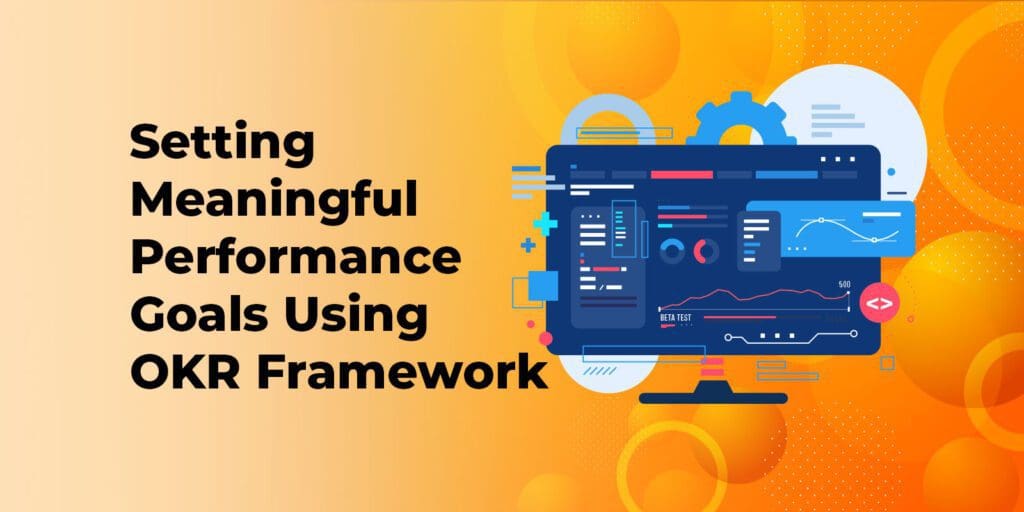Table of Contents
Setting Meaningful Performance Goals Using OKR Framework
Are you looking to achieve personal or professional growth and productivity? Are you seeking to motivate and inspire your team? One essential step towards achieving success is setting effective performance goals.
In this guide, we’ll explore practical tips and techniques for setting goals that are specific, measurable, achievable, relevant, and time-bound (SMART), as well as methods for aligning your goals with your personal or organisational values and priorities. We’ll also cover how to track your progress, stay motivated, and overcome obstacles.
Before we dive into the tips and techniques, let’s start with a quick interactive exercise to get you thinking about your own goals. Grab a pen and paper or open a blank document on your computer, and answer the following questions:
- What are some of your current personal or professional goals?
- How do these goals align with your values and priorities?
- What are some specific actions you can take to achieve these goals?
- How will you measure your progress towards these goals?
- What obstacles or challenges might you encounter along the way, and how will you overcome them?
Take a few minutes to reflect on these questions and write down your answers. This exercise will help you gain clarity about your goals, your motivations, and your potential roadblocks. It will also give you a starting point for using the tips and techniques we’ll discuss.
Now, let’s explore some practical tips and techniques for setting meaningful performance goals to help you achieve your personal and professional aspirations.
What are Performance Goals?
Performance goals are specific targets or objectives that individuals or teams set to improve their overall performance and achieve success in their personal or professional lives. These goals are often tied to specific metrics or key performance indicators (KPIs) and are designed to help individuals and teams focus their efforts, prioritise their actions, and track their progress towards achieving their desired outcomes. One popular framework for setting and achieving performance goals is the Objectives and Key Results (OKR) framework.
Who Sets Employee Performance Goals?
Employee performance goals are typically set collaboratively by the employee and their manager or supervisor. Sometimes, a team or department may also set performance goals, depending on the organisational structure and goals. Ultimately, the responsibility for setting and achieving performance goals falls on the employee, with support and guidance from their manager or supervisor.
Here’s an example of how an employee performance goal can be set:
Objective
Increase sales revenue by 15% in Q2
Key Results
Close 10 new deals with potential clients by the end of the quarter
Increase the average order value by 10%
Reduce the average sales cycle by 20%
Improve customer satisfaction ratings by 15%
Targets
- Close 10 new deals with potential clients by the end of the quarter
- Increase the average order value from $500 to $550
- Reduce the average sales cycle from 45 days to 36 days
- Improve customer satisfaction ratings from 85% to 98%
Tasks
- Research potential clients and schedule meetings with decision-makers
- Identify upsell and cross-sell opportunities with existing clients
- Analyse the sales process and identify areas for improvement
- Implement a customer feedback survey and analyse the results
- Provide training and coaching to sales team members to improve performance
By setting clear objectives, key results, targets, and tasks, an employee can work towards achieving their performance goals and contributing to the organisation’s overall success.
Understanding the OKR Framework
The OKR framework is a simple yet powerful way to set and achieve performance goals. It involves setting specific, measurable objectives and key results that define success. The framework is based on two main components:
Objectives
These are the specific goals you want to achieve. Objectives should be specific, measurable, achievable, relevant, and time-bound (SMART).
Key Results
These are the specific metrics that define success. Key results should be quantifiable, achievable, relevant, and time-bound.
The OKR framework involves setting ambitious but achievable objectives and measurable key results that align with the organisation’s overall strategy. The key to success with the OKR framework is to focus on outcomes rather than outputs. This means setting goals to achieve specific outcomes rather than simply completing tasks.


Step-by-Step Guide to Setting Performance Goals Using the OKR Framework
Now that we understand the OKR framework, let’s explore how to set performance goals using this framework. Here is a step-by-step guide to help you get started:
Step 1: Define Your Overall Objective
The first step to setting effective performance goals is to define your objectives. Objectives must be specific, measurable, achievable, relevant, and time-bound (SMART). SMART objectives help you focus on your goals and provide a clear direction for your efforts.
Specific Objectives
Specific objectives help you define what you want to achieve. For example, instead of setting a goal to “improve productivity,” set a goal to “increase sales by 10% in the next quarter.”
Measurable Objectives
Measurable objectives help you track your progress towards achieving your goals. Use metrics to measure your progress, such as the number of sales you make or the time you spend on a task.
Achievable Objectives
Achievable objectives help you set realistic goals. Ensure your goals are within reach and you have the resources and support needed to achieve them.
Relevant Objectives
Relevant objectives help you ensure your goals align with your career objectives. Ensure your goals are relevant to your career aspirations and align with your values and priorities.
Time-bound Objectives
Time-bound objectives help you set a deadline for achieving your goals. Assign deadlines to each task to ensure you stay on track and accomplish your goals within the specified timeframe.
Step 2: Break Your Objective into Key Results
Step 2 of setting performance goals involves breaking the objective into key results. Once you have identified the objective or outcome you want to achieve in Step 1, you need to identify the specific key results that will help you achieve that objective. Key results are specific, measurable, and time-bound indicators showing your progress towards your objective.
For example, if your objective is to increase sales revenue by 20% in the next quarter, your key results might include the following:
- Increase the number of sales calls by 25% per week
- Increase the average order value by 10%
- Launch a new marketing campaign targeting high-potential customers
Breaking down your objective into key results helps you focus on specific actions you need to take to achieve your objective. It also helps you measure your progress and adjust your actions as necessary to stay on track.
Step 3: Set Targets for Each Key Result
Step 3 of setting performance goals involves setting targets for each key result identified in step 2. These targets should be specific, measurable, and time-bound, which will help you track your progress towards achieving your objective.
To set targets for each key result, consider the following:
Determine the current baseline
The first step is determining where you stand regarding the key result. This will help you set a realistic target that challenges you without being unattainable.
Determine the desired outcome
What is the desired outcome for each key result? This should be clearly defined and aligned with your overall objective.
Set specific and measurable targets
Based on your baseline and desired outcome, set specific targets for each key result that can be measured objectively. For example, if your key result is to increase sales, your target could be to increase sales by 10% in the next quarter.
Assign responsibility and accountability
Ensure that each target has a clear owner who is responsible and accountable for achieving it.
Set a deadline
Set a deadline for achieving each target to ensure that progress is tracked and there is a sense of urgency in achieving them.
Setting targets for each key result ensures that your objective is broken down into manageable and measurable components, making it easier to track progress towards achieving your overall goal.
Step 4: Identify Relevant Tasks for Each Key Result
With your key results and targets in place, you must identify the specific tasks to help you achieve each key result. These tasks should be specific and actionable and directly contribute to achieving the key result. It’s important to prioritise tasks based on their impact on the key result and to assign ownership and accountability for each task.
For each key result, ask yourself what specific actions or tasks you or your employee will need to take to accomplish that result. Ensure the tasks are specific, measurable, and achievable within the given time frame. It’s also important to ensure the tasks are relevant to the key result and contribute to the overall objective.
For example, one of your key results is to increase sales revenue by 20% in the next quarter. To achieve this key result, you might need to identify relevant tasks such as:
- Conducting market research to identify potential new customers
- Developing new marketing campaigns to attract those customers
- Providing additional training to sales staff to improve their skills
- Setting up a referral program to encourage current customers to refer new business
Each task should be specific and measurable, with clear deadlines for completion. By breaking down your key results into specific tasks, you can ensure that you and your employees have a clear roadmap to achieve your goals.
Step 5: Track Your Progress and Adjust as Needed
This is a crucial step in achieving your goals because it allows you to monitor your progress and make changes if you need to make the desired progress towards your goal.
To track your progress, you need to define metrics to help you measure progress towards your goals. These metrics should be specific, measurable, and relevant to your goals. For example, if your goal is to increase sales by 20%, you can track progress by measuring weekly or monthly sales.
It’s also important to set a timeline for achieving your goals and regularly checks in to see your progress. This will help you identify any roadblocks or challenges preventing you from achieving your goals and allow you to make adjustments as needed.
If you’re not progressing towards your goals, reviewing your approach and identifying any areas where you need to make changes is important. This may involve revising your key results, adjusting your targets or identifying new tasks to focus on.
Overall, tracking your progress and making adjustments as needed is an important part of achieving your performance goals. By staying focused and committed to your goals, you can improve your performance, increase productivity, and achieve success in your career.
Benefits of the OKR Framework
There are several benefits to using the OKR framework for setting performance goals, including:
Clarity
The OKR framework clarifies what needs to be achieved, how success will be measured, and who is accountable for achieving the results.
Alignment
The OKR framework helps align individual and team efforts with the organisation’s overall objectives, ensuring everyone is working towards the same goal.
Focus
The OKR framework helps focus efforts on achieving specific outcomes rather than simply completing tasks.
Accountability
The OKR framework ensures that individuals and teams are held accountable for achieving their objectives and key results.
To Conclude
Setting performance goals using the OKR framework is an effective way to align individual goals with organisational objectives. By breaking down objectives into key results and identifying relevant tasks and targets, employees can focus on achieving measurable outcomes that drive success for themselves and their organisation.
Continually tracking progress and adjusting goals as needed ensures that individuals remain on track and accountable for their performance. With the use of OKRs, employees are empowered to work towards personal and professional growth, leading to a more motivated and productive workforce.
Overall, setting performance goals using OKRs is a practical and valuable approach for any organisation seeking to improve performance and achieve its objectives.



